Guoxi Huang
NTIRE 2025 Challenge on Day and Night Raindrop Removal for Dual-Focused Images: Methods and Results
Apr 19, 2025Abstract:This paper reviews the NTIRE 2025 Challenge on Day and Night Raindrop Removal for Dual-Focused Images. This challenge received a wide range of impressive solutions, which are developed and evaluated using our collected real-world Raindrop Clarity dataset. Unlike existing deraining datasets, our Raindrop Clarity dataset is more diverse and challenging in degradation types and contents, which includes day raindrop-focused, day background-focused, night raindrop-focused, and night background-focused degradations. This dataset is divided into three subsets for competition: 14,139 images for training, 240 images for validation, and 731 images for testing. The primary objective of this challenge is to establish a new and powerful benchmark for the task of removing raindrops under varying lighting and focus conditions. There are a total of 361 participants in the competition, and 32 teams submitting valid solutions and fact sheets for the final testing phase. These submissions achieved state-of-the-art (SOTA) performance on the Raindrop Clarity dataset. The project can be found at https://lixinustc.github.io/CVPR-NTIRE2025-RainDrop-Competition.github.io/.
Bayesian Neural Networks for One-to-Many Mapping in Image Enhancement
Jan 24, 2025



Abstract:In image enhancement tasks, such as low-light and underwater image enhancement, a degraded image can correspond to multiple plausible target images due to dynamic photography conditions, such as variations in illumination. This naturally results in a one-to-many mapping challenge. To address this, we propose a Bayesian Enhancement Model (BEM) that incorporates Bayesian Neural Networks (BNNs) to capture data uncertainty and produce diverse outputs. To achieve real-time inference, we introduce a two-stage approach: Stage I employs a BNN to model the one-to-many mappings in the low-dimensional space, while Stage II refines fine-grained image details using a Deterministic Neural Network (DNN). To accelerate BNN training and convergence, we introduce a dynamic \emph{Momentum Prior}. Extensive experiments on multiple low-light and underwater image enhancement benchmarks demonstrate the superiority of our method over deterministic models.
Incrementally Learning Multiple Diverse Data Domains via Multi-Source Dynamic Expansion Model
Jan 15, 2025



Abstract:Continual Learning seeks to develop a model capable of incrementally assimilating new information while retaining prior knowledge. However, current research predominantly addresses a straightforward learning context, wherein all data samples originate from a singular data domain. This paper shifts focus to a more complex and realistic learning environment, characterized by data samples sourced from multiple distinct domains. We tackle this intricate learning challenge by introducing a novel methodology, termed the Multi-Source Dynamic Expansion Model (MSDEM), which leverages various pre-trained models as backbones and progressively establishes new experts based on them to adapt to emerging tasks. Additionally, we propose an innovative dynamic expandable attention mechanism designed to selectively harness knowledge from multiple backbones, thereby accelerating the new task learning. Moreover, we introduce a dynamic graph weight router that strategically reuses all previously acquired parameters and representations for new task learning, maximizing the positive knowledge transfer effect, which further improves generalization performance. We conduct a comprehensive series of experiments, and the empirical findings indicate that our proposed approach achieves state-of-the-art performance.
BVI-RLV: A Fully Registered Dataset and Benchmarks for Low-Light Video Enhancement
Jul 03, 2024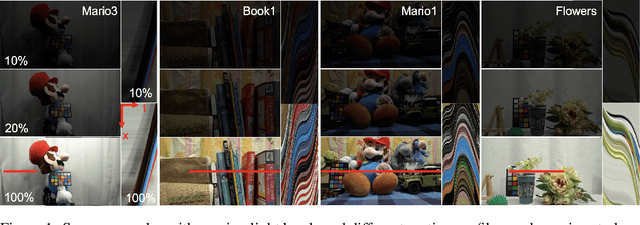
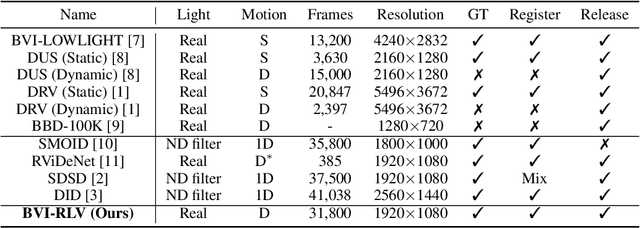
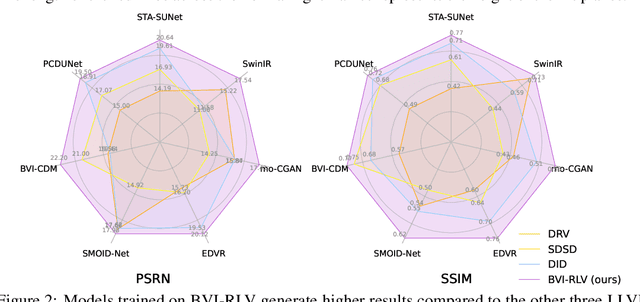
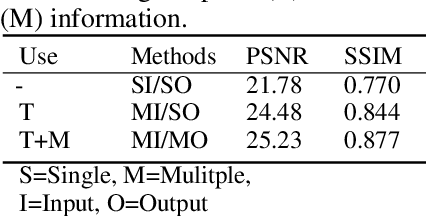
Abstract:Low-light videos often exhibit spatiotemporal incoherent noise, compromising visibility and performance in computer vision applications. One significant challenge in enhancing such content using deep learning is the scarcity of training data. This paper introduces a novel low-light video dataset, consisting of 40 scenes with various motion scenarios under two distinct low-lighting conditions, incorporating genuine noise and temporal artifacts. We provide fully registered ground truth data captured in normal light using a programmable motorized dolly and refine it via an image-based approach for pixel-wise frame alignment across different light levels. We provide benchmarks based on four different technologies: convolutional neural networks, transformers, diffusion models, and state space models (mamba). Our experimental results demonstrate the significance of fully registered video pairs for low-light video enhancement (LLVE) and the comprehensive evaluation shows that the models trained with our dataset outperform those trained with the existing datasets. Our dataset and links to benchmarks are publicly available at https://doi.org/10.21227/mzny-8c77.
Layered Rendering Diffusion Model for Zero-Shot Guided Image Synthesis
Nov 30, 2023Abstract:This paper introduces innovative solutions to enhance spatial controllability in diffusion models reliant on text queries. We present two key innovations: Vision Guidance and the Layered Rendering Diffusion (LRDiff) framework. Vision Guidance, a spatial layout condition, acts as a clue in the perturbed distribution, greatly narrowing down the search space, to focus on the image sampling process adhering to the spatial layout condition. The LRDiff framework constructs an image-rendering process with multiple layers, each of which applies the vision guidance to instructively estimate the denoising direction for a single object. Such a layered rendering strategy effectively prevents issues like unintended conceptual blending or mismatches, while allowing for more coherent and contextually accurate image synthesis. The proposed method provides a more efficient and accurate means of synthesising images that align with specific spatial and contextual requirements. We demonstrate through our experiments that our method provides better results than existing techniques both quantitatively and qualitatively. We apply our method to three practical applications: bounding box-to-image, semantic mask-to-image and image editing.
Masked Image Residual Learning for Scaling Deeper Vision Transformers
Sep 25, 2023Abstract:Deeper Vision Transformers (ViTs) are more challenging to train. We expose a degradation problem in deeper layers of ViT when using masked image modeling (MIM) for pre-training. To ease the training of deeper ViTs, we introduce a self-supervised learning framework called \textbf{M}asked \textbf{I}mage \textbf{R}esidual \textbf{L}earning (\textbf{MIRL}), which significantly alleviates the degradation problem, making scaling ViT along depth a promising direction for performance upgrade. We reformulate the pre-training objective for deeper layers of ViT as learning to recover the residual of the masked image. We provide extensive empirical evidence showing that deeper ViTs can be effectively optimized using MIRL and easily gain accuracy from increased depth. With the same level of computational complexity as ViT-Base and ViT-Large, we instantiate 4.5{$\times$} and 2{$\times$} deeper ViTs, dubbed ViT-S-54 and ViT-B-48. The deeper ViT-S-54, costing 3{$\times$} less than ViT-Large, achieves performance on par with ViT-Large. ViT-B-48 achieves 86.2\% top-1 accuracy on ImageNet. On one hand, deeper ViTs pre-trained with MIRL exhibit excellent generalization capabilities on downstream tasks, such as object detection and semantic segmentation. On the other hand, MIRL demonstrates high pre-training efficiency. With less pre-training time, MIRL yields competitive performance compared to other approaches.
Dynamic Appearance: A Video Representation for Action Recognition with Joint Training
Nov 24, 2022
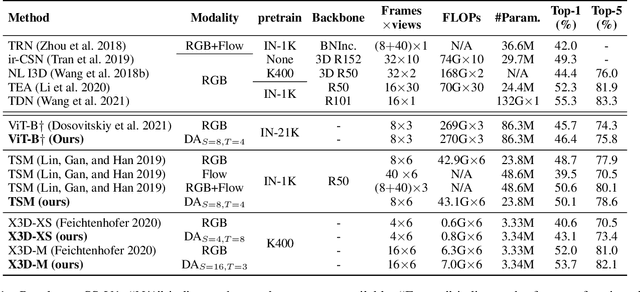
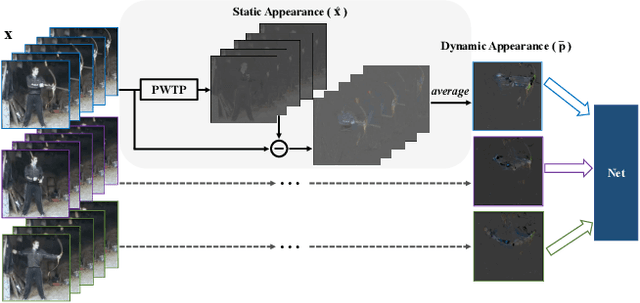
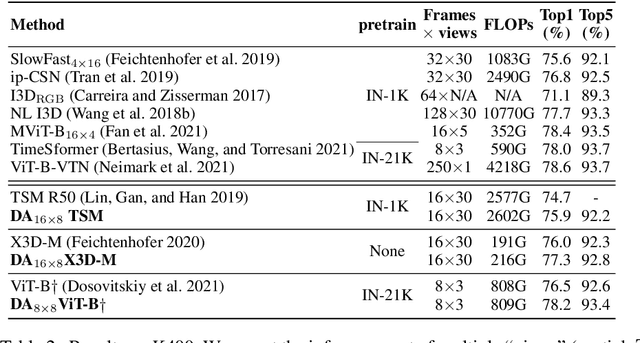
Abstract:Static appearance of video may impede the ability of a deep neural network to learn motion-relevant features in video action recognition. In this paper, we introduce a new concept, Dynamic Appearance (DA), summarizing the appearance information relating to movement in a video while filtering out the static information considered unrelated to motion. We consider distilling the dynamic appearance from raw video data as a means of efficient video understanding. To this end, we propose the Pixel-Wise Temporal Projection (PWTP), which projects the static appearance of a video into a subspace within its original vector space, while the dynamic appearance is encoded in the projection residual describing a special motion pattern. Moreover, we integrate the PWTP module with a CNN or Transformer into an end-to-end training framework, which is optimized by utilizing multi-objective optimization algorithms. We provide extensive experimental results on four action recognition benchmarks: Kinetics400, Something-Something V1, UCF101 and HMDB51.
Video Classification with FineCoarse Networks
Mar 29, 2021



Abstract:A rich representation of the information in video data can be realized by means of frequency analysis. Fine motion details from the boundaries of moving regions are characterized by high frequencies in the spatio-temporal domain. Meanwhile, lower frequencies are encoded with coarse information containing substantial redundancy, which causes low efficiency for those video models that take as input raw RGB frames. In this work, we propose a Motion Band-pass Module (MBPM) for separating the fine-grained information from coarse information in raw video data. By representing the coarse information with low resolution, we can increase the efficiency of video data processing. By embedding the MBPM into a two-pathway CNN architecture, we define a FineCoarse network. The efficiency of the FineCoarse network is determined by avoiding the redundancy in the feature space processed by the two pathways: one operates on downsampled features of low-resolution data, while the other operates on the fine-grained motion information captured by the MBPM. The proposed FineCoarse network outperforms many recent video processing models on Kinetics400, UCF101 and HMDB51. Furthermore, our approach achieves the state-of-the-art with 57.0% top-1 accuracy on Something-Something V1.
Region-based Non-local Operation for Video Classification
Jul 24, 2020



Abstract:Convolutional Neural Networks (CNNs) model long-range dependencies by deeply stacking convolution operations with small window sizes, which makes the optimizations difficult. This paper presents region-based non-local operation (RNL), a family of self-attention mechanisms, which can directly capture long-range dependencies without a deep stack of local operations. Given an intermediate feature map, our method recalibrates the feature at a position by aggregating information from the neighboring regions of all positions. By combining a channel attention module with the proposed RNL, we design an attention chain, which can be integrated into off-the-shelf CNNs for end-to-end training. We evaluate our method on two video classification benchmarks. The experimental result of our method outperforms other attention mechanisms, and we achieve state-of-the-art performance on Something-Something V1.
Learning spatio-temporal representations with temporal squeeze pooling
Feb 11, 2020



Abstract:In this paper, we propose a new video representation learning method, named Temporal Squeeze (TS) pooling, which can extract the essential movement information from a long sequence of video frames and map it into a set of few images, named Squeezed Images. By embedding the Temporal Squeeze pooling as a layer into off-the-shelf Convolution Neural Networks (CNN), we design a new video classification model, named Temporal Squeeze Network (TeSNet). The resulting Squeezed Images contain the essential movement information from the video frames, corresponding to the optimization of the video classification task. We evaluate our architecture on two video classification benchmarks, and the results achieved are compared to the state-of-the-art.
 Add to Chrome
Add to Chrome Add to Firefox
Add to Firefox Add to Edge
Add to Edge